
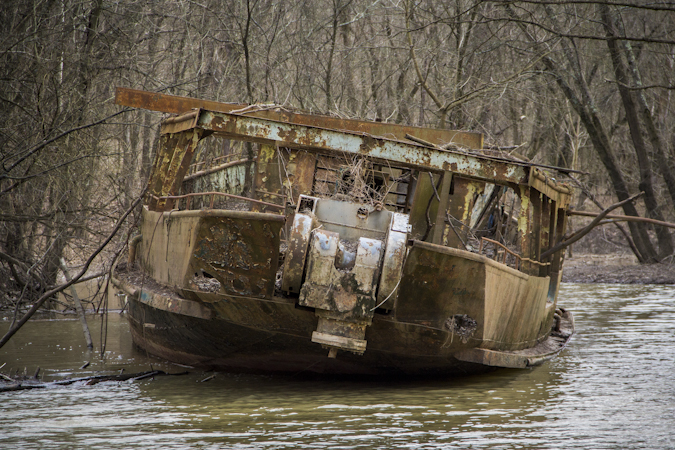
Hikers and outdoor enthusiasts in the Midwest have been startled by the appearance of a ghostly ship that is abandoned and rusting in a tiny creek in the backwoods of Kentucky. This ship, which is located in thick forest 25 miles south of Cincinnati, Ohio, is nearly hidden behind old trees, weeds, driftwood and large reeds. But if you are hiking through the forest and paddle up the creek, there she is: the Celt, also known as the USS Phenakite, also known as the USS Sachem, also known as the Sightseer, also known as the Circle Line V.
The Luxury Yacht Celt

This mysterious ship began its life as a yacht called the Celt, which was built for J. Rogers Maxwell in 1902. Maxwell was a wealthy railroad executive from New Jersey. Maxwell and his son, J. Rogers Jr., were heavily involved in the yacht racing of the era.
The Celt was 128-feet long and powered by steam. It had a top speed of 13 knots, and was capable of hauling up to 217 tons GRT. It was built by the Pusey and Jones Co., from Wilmington, Delaware, which was one of the major shipbuilders in America until 1959. J. Rogers’ Maxwell’s greatest claim to fame was winning the 1907 King’s Cup race with one of his other yachts, defeating the legendary Commodore Vanderbilt to take the prize.
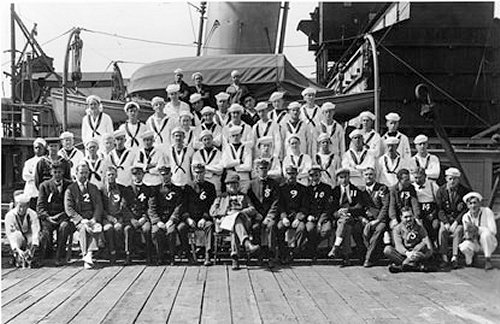 After a few years in Maxwell’s stable of boats, Maxwell died. His widow sold the boat to Manton B. Metcalf of New York. Metcalf made his fortune in the textile industry. His summer mansion in Rumson was built during the roaring twenties. The New York Times compared it to the home of the fictional Jay Gatsby.
After a few years in Maxwell’s stable of boats, Maxwell died. His widow sold the boat to Manton B. Metcalf of New York. Metcalf made his fortune in the textile industry. His summer mansion in Rumson was built during the roaring twenties. The New York Times compared it to the home of the fictional Jay Gatsby.
The USS Sachem
When America was on the brink of war, the United States Navy acquired the Celt on July 3, 1917. The yacht was converted to a coastal patrol boat. Christened the USS Sachem, for service in World War I.
The Germans had developed the U-boat, which were submarines that patrolled the Atlantic in search of British supply vessels. In addition to sinking British ships, the Germans were out to destroy any ship that was supplying the British. In addition, the Germans knew that the U.S. was likely preparing to enter the War, so they turned their attention to the American coastline.
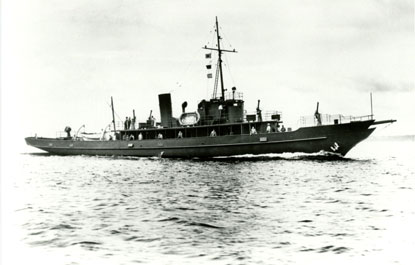
In response, the U.S. Navy put together a fleet of fast ships capable of outmaneuvering the U-boats. The USS Sachem was one of these vessels, and it was deployed to protect the American coastline. The Sachem was retrofitted with depth charges that gave it the ability to sink U-boats, and machine guns were added to counteract German torpedoes. The masts were removed and the ornate brass portholes were sealed with steel. The sides were also raised.
The Navy knew it had to develop more sophisticated vessels in order to keep pace with the Germans. They turned to inventor Thomas Edison, and loaned him the USS Sachem for experiments. Edison conducted experiments on the ship between August and September of 1917, with many of the experiments designed to camouflage ships and hide torpedo detection. During this time, the Sachem was decked out with instruments allowing it to search for submarines with sound, magnetic fields, and sight.
Thomas Edison on the Sachem

Edison spent eighteen months investigating issues for the US Navy, eventually coming up with 48 projects, such as special coating for submarine guns, an anti-roll platform for rough seas, and a hydrogen detector to help ships avert undersea explosions.
The Sachem Becomes a Fishing Boat
After the War, the USS Sachem was decommissioned and returned to Metcalf in 1919. Eventually the ship was sold again, this time to a captain named Jake Martin, from Brooklyn. He converted the war yacht into a fishing ship. Captain Martin is a mercurial character from the 1930s. By the time he acquired the ship, America was embroiled in the Great Depression. As a result, luxury ships like the Celt were suddenly affordable to anyone.
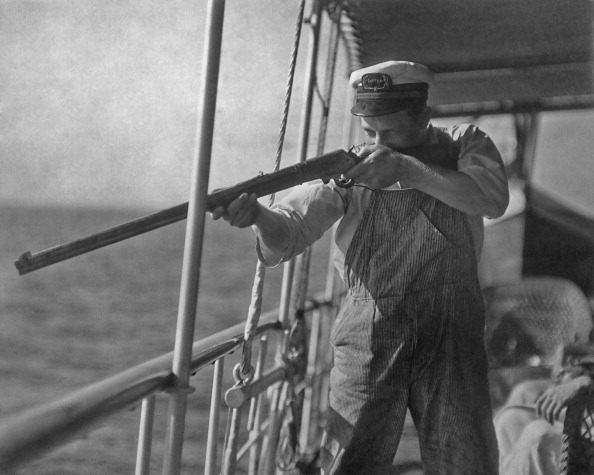
Captain Martin charged people $2.00 to board the boat. Captain Martin’s claim to fame was pioneering the industry of party boat fishing. The first converted steam yacht that was used as a party fishing boat was his vessel, the Evelyn.

This postcard is the first advertisement for the Sachem as a fishing party boat. It shows Capt. Martin. Captain Martin and his son, Chubby Martin, then put the Sachem to use in Sheepshead Bay.
This 1937 postcard shows the boat once again, calling it the “Longest, Fastest and Finest” diesel yacht.
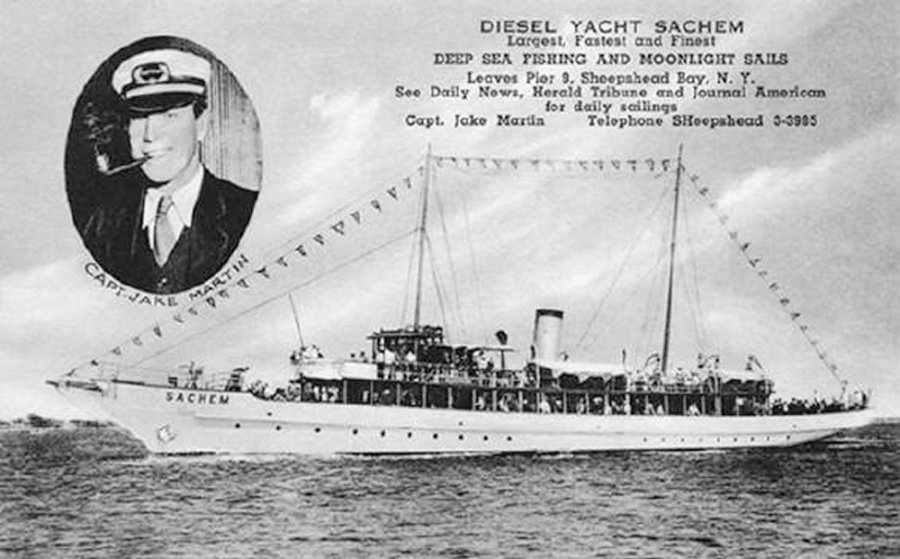
Martin had eliminated the coal engine and installed a diesel engine. According to Michael Daniewicz, an amateur maritime historian, the Sachem “was a remarkable vessel and was the queen of the fleet in her day.”
Just what was a party fishing boat? Daniewicz said the purpose was to allow people to pool their resources in order to get food. One person would come aboard and catch a large fish to take home. “It was well worth it for neighbors to send out one person, usually a young, strong man, to catch these huge fish that would feed several families,” Daniewicz said. “People couldn’t believe these yachts with mahogany millwork and brass light fixtures were used for fishing, but the trips were quite popular and the business flourished.”
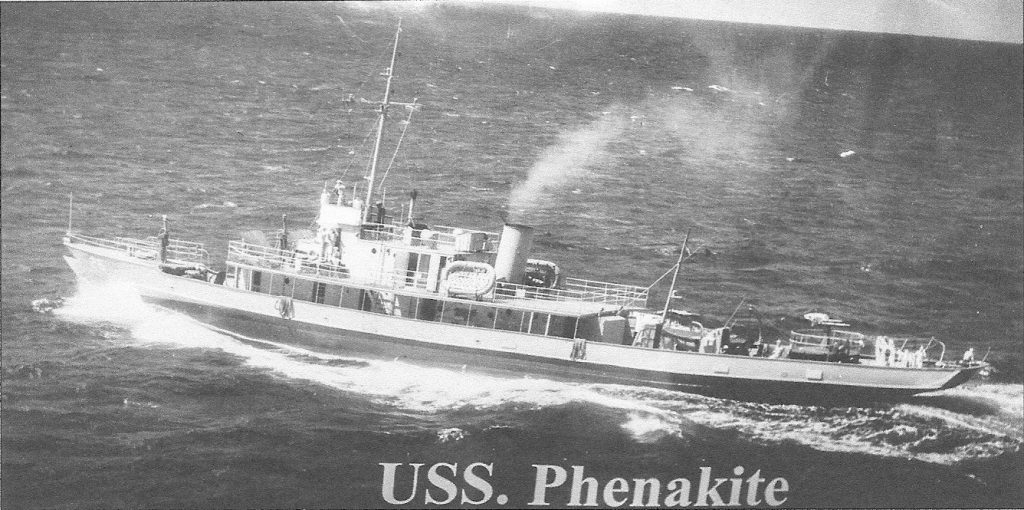
By 1942, the United States was on the brink of war once again. The Navy came calling, and this time they purchased the boat from Martin for $65,000.
The USS Phenakite
Robert Jacobs, Inc., had the job of making the vessel back into a war machine. It was then commissioned by the Navy as the USS Phenakite (PYc-25). Phenakite is a kind of gemstone. As the Phenakite, the boat set sail in Tompkinsville, New York on July 1. Its job this time around was to patrol the waters off the Florida Keys and to train sailors.
The world had changed a lot since WWI. The German U-boats were back, except this time they were more sophisticated, employing the use of sonar. The Phenakite trained sailors in the Keys on how to use sonar. At night the boat would patrol the area, ensuring that any oncoming German U-boats were discovered and kept at bay.
This photograph of the USS Phenakite shows how different the vessel looked in its US Navy bearing.
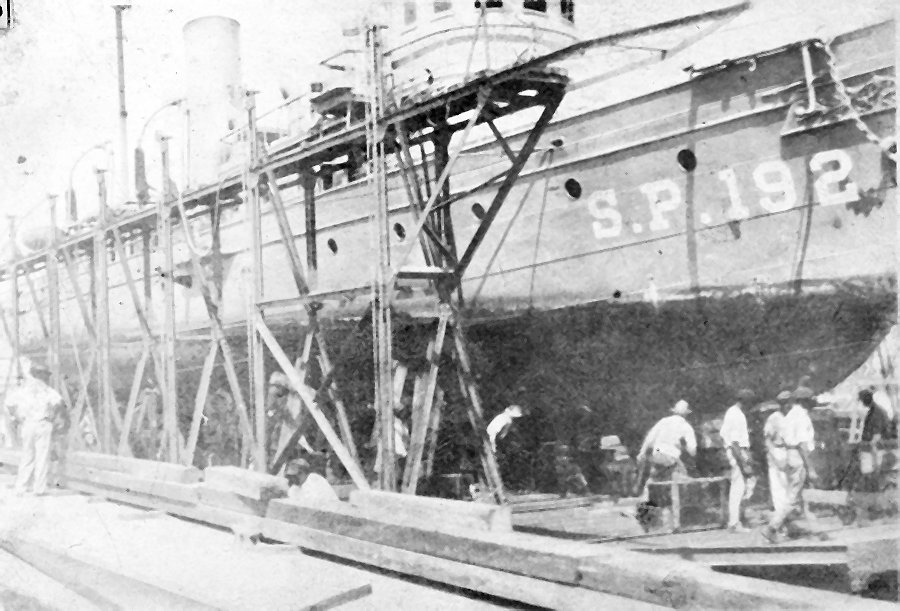
The Phenakite eventually relocated to the Long Island Sound, where it served out the rest of the War. It was decommissioned on November 5, 1945, and then given to the Maritime Commission for disposal. It then returned to Captain Martin, who put it back in the water in its former guise. Captain Martin named it the Sachem once again and it was back to work as a fishing boat as of December 29, 1945.
The Sachem/Phenakite ended its distinguished Naval career with some awards. It was given the World War One Victory Medal (previously known as the Victory Medal), the American Campaign Medal (established by President Roosevelt for service within the American Theater between 7 December 1941 and 2 March 1946) and the World War II Victory Medal (also known as the Victory Medal).
The Sightseer
World War II had ended in the summer of 1945, and America then entered a prosperous post-war period. Returning GIs and their families enjoyed economic growth, leading many to settle down, buy houses and have children. Tourism boomed in New York City. At this time, several different cruise liners merged to start a boat tourism company called Circle Line Sightseeing Cruises. The company set about purchasing boats suitable for their business. Captain Martin sold the Sachem to the Circle Line group, which immediately made it their flagship.
As this postcard shows, Circle Line renamed the ship Sightseer.
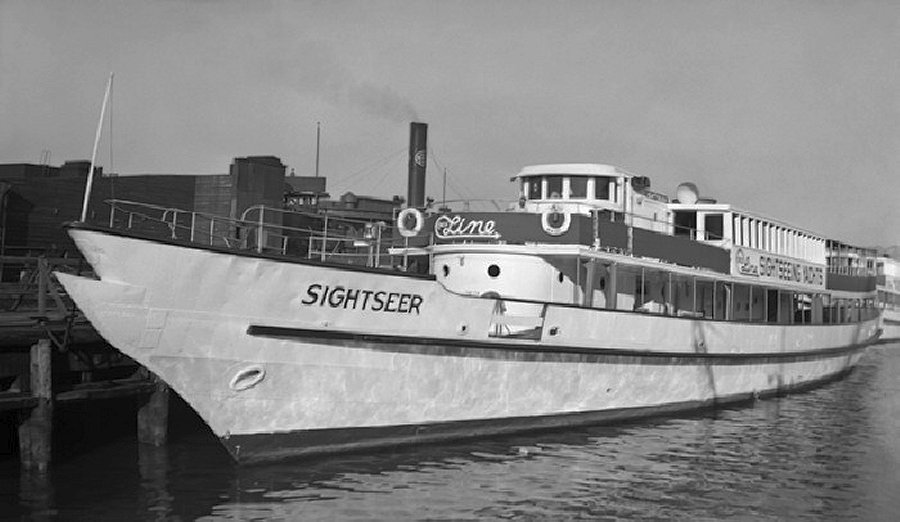
It was modified to seat over 500 passengers. Over the next several decades, the Sightseer ferried millions of tourists around the East River. The Circle Line still exists today, with nine vessels, multiple bus tours around New York’s Five Burroughs and more than 2,000 visitors daily.
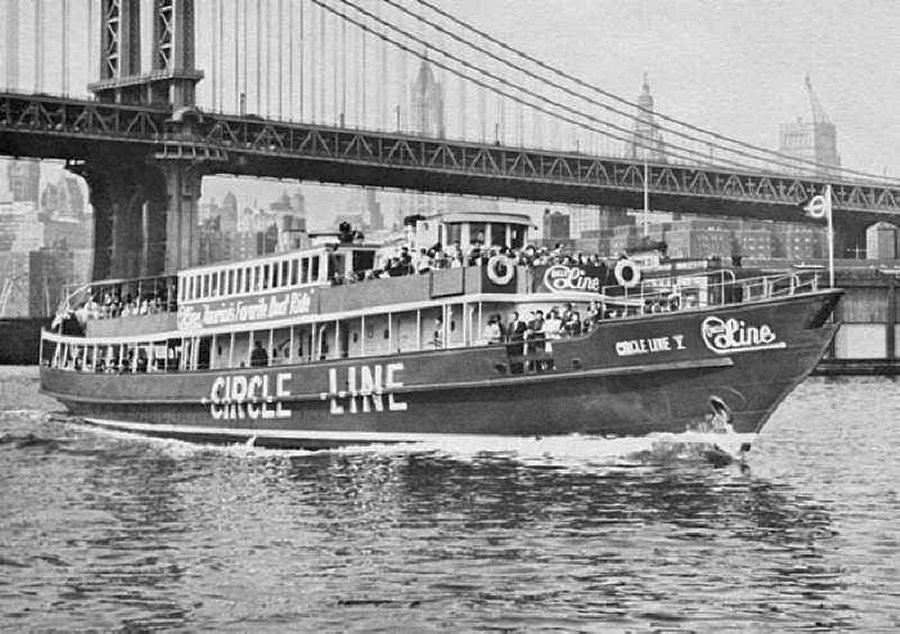
The boat’s original interiors were well preserved. There were two deck houses made of solid mahogany, with brass handrails and teak sills. The state rooms were also done in mahogany, and they contained adjoining bathrooms, complete with mosaic-tiled floors, porcelain walls of a five-foot depth. The boat even had modern plumbing and electric power. Its original masts were made from Oregon pine.
Circle Line V Cruises the Hudson
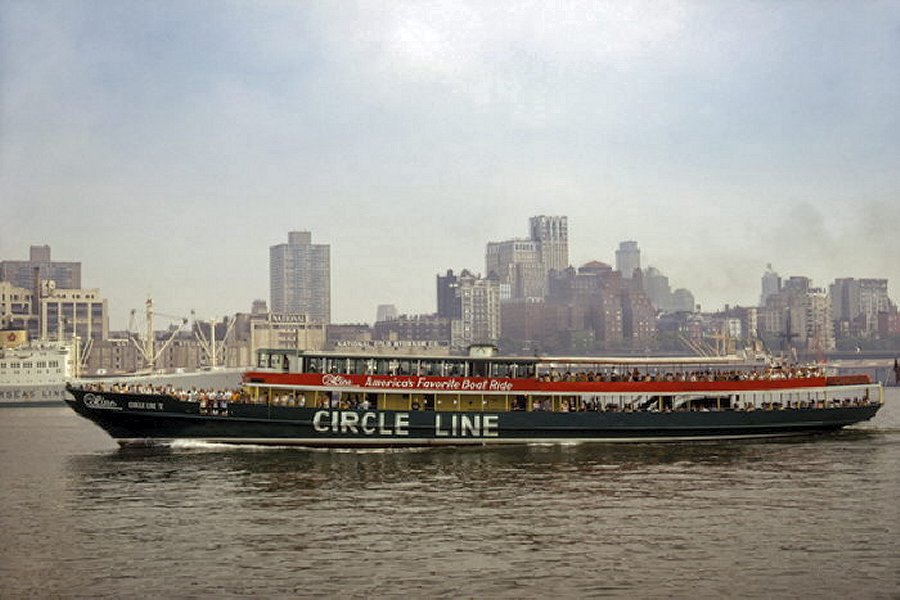
This postcard from 1969 shows the ship as it was eventually renamed, the Circle Line V. This is the first known color photograph of the boat, with its newly painted red and navy hull.
She was used by the tourist company until 1983. Circle Line had grown so popular that the Circle Line V could no longer meet the demand of so many passengers. The company cut the boat from their fleet and left it. The boat was briefly moored at an abandoned pier at Weehawken, New Jersey.
This grainy photo shows her in this state.
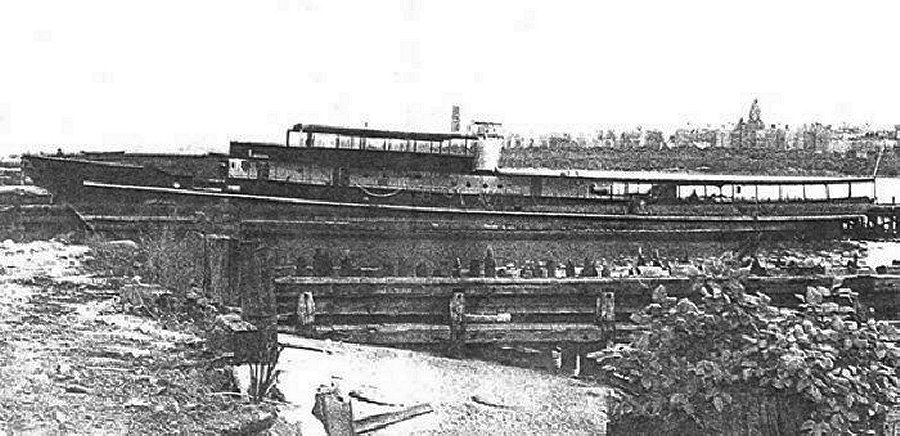
Circle Line stripped the boat of its most important equipment and even the best timber. The pilothouse was removed and relocated to the company’s permanent location, where it is used as a ticket sales kiosk. The boat was officially donated to the Sea Scouts, which is a group of Boy Scouts that is dedicated to preserving maritime history.
Madonna Boards the Sightseer
This is when the tale of the Sightseer gets even more interesting. During the 1980s, no one was a bigger music star than Madonna. With her ever-changing look and shocking songs, Madonna was as much a performance artist as recording artists. She made her mark with a series of pioneering videos for brand new television network, MTV.

Meanwhile, a man from Cincinnati named Robert “Butch” Miller caught wind of the ship. He had been looking to buy an old steam ship and had difficulty finding one. “In 1986, I finally came across one that fit the description and called the guy up,” Miller, who now lives in Mexico City, said. “He said it can’t sail right now, but it was once used by Thomas Edison.” When Miller saw the Sightseer, he thought it would be the perfect vessel, but only if it could be restored. “The (seller) was selling his property,” he recalled, “and this was the last thing that was left. Everybody was afraid of it. They had tried to move it out a couple of times and it didn’t move. They tried to move it with bulldozers,” but the boat wouldn’t budge, because of its steel hull.
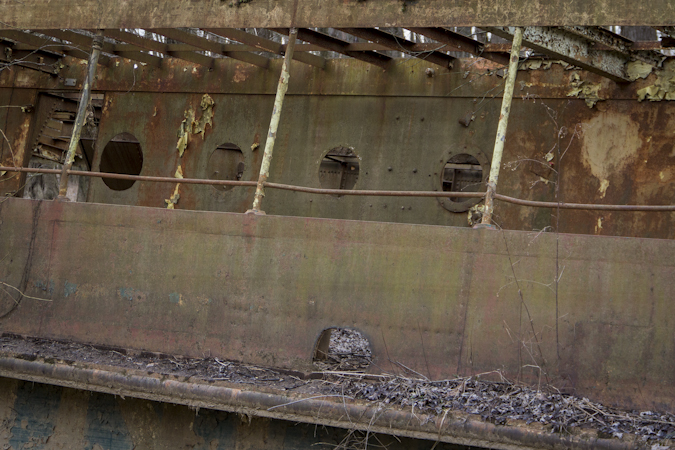
In 1986, Miller purchased it for just $7,500. It took several tugboats to move it down the Hudson. Since the boat had been stripped down, Miller needed to make it seaworthy again. Miller took months to restore the yacht in order to sail it to its new home in the Midwest. Miller was the latest in a long line of interesting characters who owned the boat. In order to enjoy the boat without paying dock fees, Miller sailed it around New York and New Jersey for several months.
The restoration was difficult. When he was living on the boat, Miller had the choice of sleeping in the bathroom – which initially was covered in several feet of mud – or sleeping outside on the deck.

In 1986, Madonna was undergoing her second official image makeover. Her third studio album, True Blue, was a smash hit. The song “Papa Don’t Preach” was about teen pregnancy, and it featured Madonna telling her father she was pregnant and keeping the baby. The video became a flashpoint in the culture war about abortion. For the video, Madonna debuted a cropped blonde haircut and more muscular frame.
Director James Foley shot the video on location in Staten Island and Manhattan over three days in 1986. Foley had grown up in Staten Island and he and Madonna wanted to show a more working-class background, since Madonna had already done the glamorized Material Girl. This was a departure for Madonna, and it took her back to her Detroit roots.
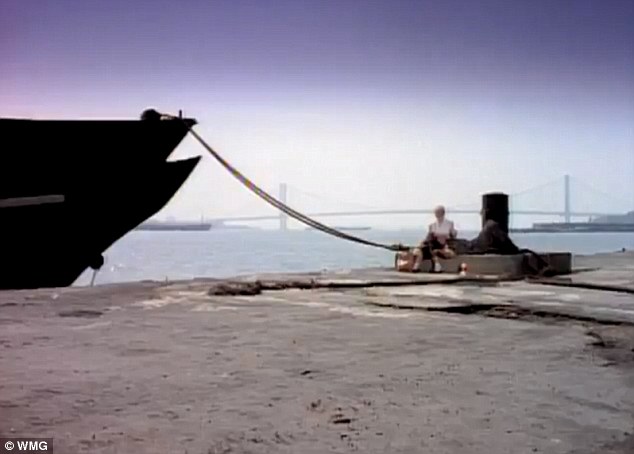
The regular guy from Cincinnati then had a brush with Hollywood. One day Miller was working on the docks when a limousine pulled up. A man got out and asked if he would loan the boat out for a Madonna video. “A guy got out and told me Madonna was shooting a video and wanted to use the boat for background,” Miller said. “I couldn’t believe it, but I said ‘why not?'” And that’s how Madonna wound up singing and walking on the planks of the old Sightseer.
The video became a huge hit and it also starred Danny Aiello as Madonna’s father. Miller didn’t take any money for it. “They offered me a little bit of money, but I told them to keep it,” he said. Director Foley went on to direct the movies at Close Range (starring Sean Penn and Christopher Walken), Glengarry Glenn Ross (starring Alec Baldwin) and The Chamber (based on the John Grisham novel).
The Sachem Comes to Kentucky

Miller celebrated his purchase with a party in New York Harbor. Over the Fourth of July weekend, he and friends took the boat out to see the ceremonial rededication and lighting of the Statue of Liberty, which took place on July 4, 1986. Miller’s then-wife remembered, “Somebody gave us a break on docking because the statue was due to be unveiled. That was an amazing celebration and people were just fascinated with the Sachem. The engine room took up part of two decks of the boat.”
Then, Miller sailed her back to Cincinnati. The trip to Cincinnati was a long journey – over 2,600 miles! To safeguard his purchase, Miller bought a 12-foot tugboat from 1881, just in case the Sachem broke down. The boat first chartered a course up the Hudson River, then across the Great Lakes. From there, it connected with the Mississippi River, which then flows into the Ohio River. Sailing the boat that far after so many years of service was quite a feat. “It’s amazing that we were able to do it,” said wife Deborah Kahles. “We had to take the stacks off to get it under the bridges.”

With a crew of four or five people, the ship sailed at a top speed of 10 miles an hour in the Mississippi. Once they reached the Ohio River, the boat crawled to a top speed of just two miles an hour, if that.
Once it passed the Markland Dam, Miller and his mates steered the ship into a narrow channel. From there, a tugboat dragged it into its final resting place, in Taylor Creek, Kentucky.
The Ghost Ship at Rest

Miller has only officially commented on his find once in recent years. He said his first intent was to put the ship in a museum, after it underwent a restoration. Miller and his wife took the boat to a piece of property they owned in Boone County, Kentucky, just south of Cincinnati.
That’s where the boat still sits, rusting in the muck, still sporting its old Circle Line paint job. It has hauled nearly 2.9 million people over more than 100 years. Adventure seekers have sought out the spot, photographing the ghost ship in its sorry state. Sometimes it sits on muddy ground. In other years, when rains are heavy, it gets nearly completely submerged and several photos show it listing to one side.
If you get close enough, you can see the blue paint and “C Line” emblem. The words Circle Line are also visible on the side of the boat.

The boat had a historically significant engine. The original steam engine was a four-cylinder in an open engine room. Miller said that “Norman Brauer, the curator of the South Street Seaport Museum (in New York City) said that there are only three of these steam engines left in the world.” Unfortunately, vandals and graffiti artists also had their way with the boat when it was in New York. The engine is now long gone.
The Raise the Sachem Campaign

Miller has said he is disappointed about the condition of the boat. Unfortunately, he has left the country and no longer has enough money to make the substantial repairs necessary to fix the boat, let alone to make it seaworthy. However, Miller knows his boat is a very significant piece of American history and he would like to see it raised. It would take at least a million dollars to raise the boat and make it a viable museum exhibit. A local pizza family is trying to raise funds to do just that. The D’Andrea LaRosa Art Foundation, which was started by one of the founders of LaRosa’s Pizza, started a “Raise the Sachem” campaign. Despite its website and Facebook page, it does not appear that the boat will be raised any time soon.
For those who would like to see the boat, a trip to the tristate area is necessary. The boat sits in the creek in Kentucky, just across the river from Lawrenceburg, Indiana, a tributary of the Ohio River. Although it is visible from a nearby field, when the water is high, visitors need to paddle across the water to get the best look.

The boat has now been rotting for nearly 30 years. Vegetation is growing up on the decks. The porthole glass is broken but still there. The stairs are rusted out and lead straight into the sky. The stairs once took visitors to New York Harbor up to a sightseeing deck. Locals are generally friendly to explorers, but be wary, since they have run off people who have visited the boat in order to steal scrap metal.

Although many people have now heard of the boat, few knew of its incredible history until explorers started doing the research. For now, that may be the end of the story. The incredible luxury yacht that became a war vessel, that became a sightseeing ship, that had a cameo in a major music video, appears to have found her final resting place.






